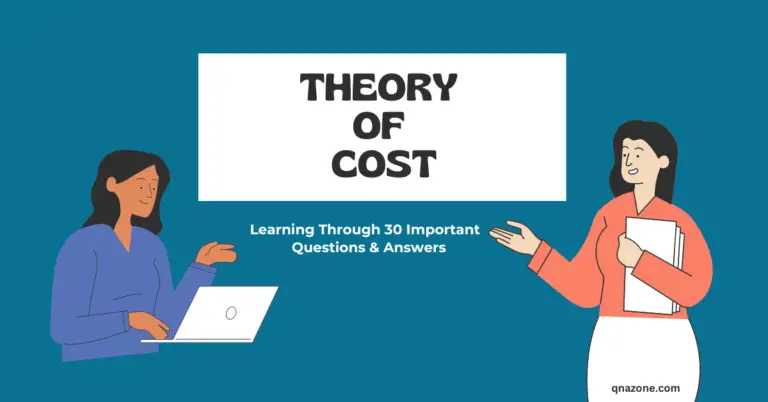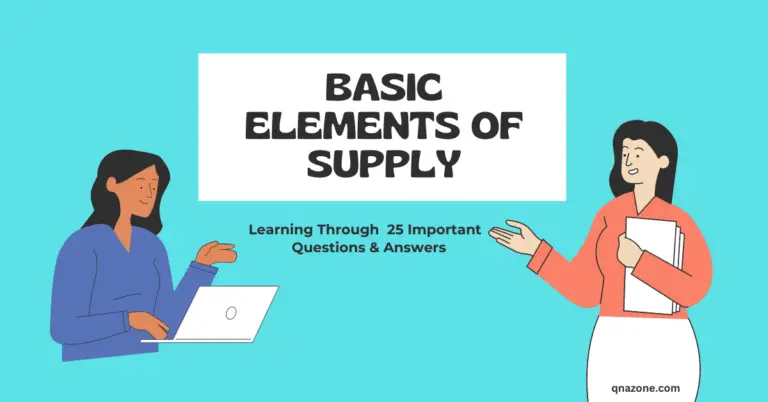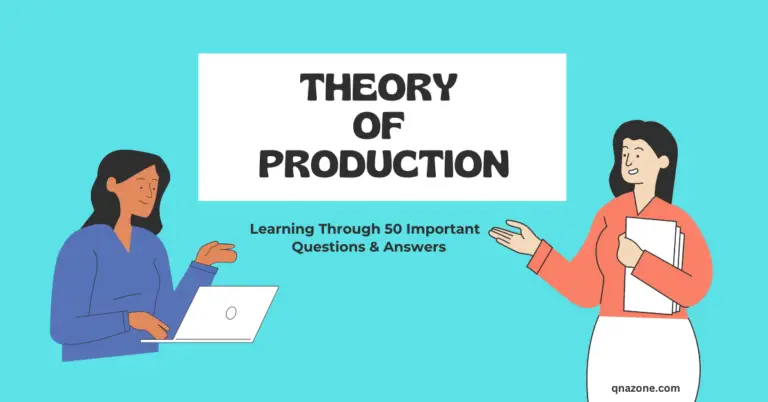25 Important Concepts of Economics Questions and Answers [With PDF]
The second chapter of our economics learning course is “Concepts of Economics.” In this article, we’ll learn the 25 most important “concepts of economics” questions and their answers.
These simple questions and answers will help you quickly understand what economic resources are, as well as examples and characteristics of economic resources, various types of economic resources and goods, income, savings, investment, and much more.
By reading this post, you can quickly prepare for economics courses as well as other competitive exams such as Vivas, job interviews, and school and college exams.
So let’s get started.
Concepts of Economics Questions and Answers
The 25 most important “concepts of economics” questions and answers are as follows:
Question 01: What are the economic resources?
Answer: We’ve all heard the term “resource” at some point in our lives. The word “resource” appears in our daily conversations in a variety of contexts. For example, Mr. Paul has a lot of resources. Everything is not a resource in the eyes of an economist. In economics, these are resources that can be obtained by spending money.
Question 02: What are examples of economic resources?
Answer: The following are some examples of economic resources:
- House
- Land
- Building
- Furniture
- Computer
- Doctor’s services
- Teacher’s lessons
Question 03: What are the characteristics of economic resources?
Answer: In economics, a resource must have four characteristics. These are the following:
- The utility is the ability of people to meet their needs. If a product has no utility, no one will desire that product and spend money instead of it. So resources must have utility or capacity to meet shortages.
- There is no saying that people will be motivated to spend money on a product only if it is useful. For example, wind, river water, and sunlight have utility, but since they are infinite in supply, they have no exchange value. That is, if a commodity is to be a resource, its supply will be less than its demand.
- Another characteristic of wealth is transferability. In general, transferability means the transfer of goods from one place to another. But transferability in economics means a change of ownership of goods. For example, a house or land cannot be moved from one place to another, but a change of ownership is possible through a sale. So a house or land is wealth.
- To be economic goods or resources, those goods must have an externality, or external existence, like houses, furniture, doctor services, etc. But the inherent virtue of man is not wealth. For example, the poet’s talent, the mother’s affection, the doctor’s skill, etc. are not wealth.
Question 04: What are the different kinds of economic resources?
Answer: The following are the different kinds of economic resources:
As per their origins:
- Natural resources
- Human resources
- Man-made resources
According to ownership:
- Private property
- Collective properties
- National Properties
- International properties
Question 05: What are natural resources?
Answer: Natural resources are things that are obtained naturally from nature. For example, land, water, climate, plants, rivers, mineral resources, and so on.
Question 06: What are human resources?
Answer: “Human resources” refers to people’s human or inner qualities. For example, health, enthusiasm, intelligence, skill, and honesty. They are not called assets in economics because they are not transferable and have no external entity.
Question 07: What are man-made resources?
Answer: Man-made resources are those created by humans from natural and human resources. For example, houses, machinery, roads, educational institutions, hospitals, and so on.
Question 08: What is private property?
Answer: Assets owned by individuals are private property. For example, cars, houses, furniture, etc.
Question 09: What are the collective properties?
Answer: Collective properties are things that the state and the general public own together. Examples of collected properties include roads, parks, zoos, post offices, hospitals, and more.
Question 10: What are national properties?
Answer: National properties are essentially a combination of individual and collective properties. For example, people’s reputations, technical resources, mineral resources, etc.
Question 11: What are international properties?
Answer: International properties are resources that don’t belong to just one country but can be used by all countries. Seas, oceans, and international rivers are a few examples of global resources and properties.
Question 12: What are the different types of resources?
Answer: The different types of resources are as follows:
- Agricultural Resources
- Mineral Resources
- Forest Resources
- Animal Resources
- Energy Resources
- Water Resources
Question 13: What are goods?
Answer: All material and immaterial resources are called goods. All the resources that have the ability to fulfill human satisfaction are called goods. Food, clothing, shelter, chairs, tables, and surfaces are all material goods. Again, business reputation, human qualities, light, and air are immaterial goods.
Question 14: What are freely accessible goods?
Answer: Free-access goods are those that can be obtained without spending any money. These products are freely available and have an endless supply in nature. for example, light, the wind, river water, etc.
Question 15: What are economic goods?
Answer: Economic goods are those that are hard to get in large quantities and are in short supply. For example, food, shelter, city water, natural gas, etc. All these goods come at a cost to the consumer.
Question 16: What are permanently consumable goods?
Answer: Goods that can be used up over a long period of time are called “permanently consumable goods.” such as a refrigerator, vehicles, homes, parcels of land, playgrounds, etc.
Question 17: What are temporary consumable goods?
Answer: Temporarily consumable goods are those that are intended to be used up quickly, sometimes only once. for example, food, clothes, accessories, vegetables, etc.
Question 18: What are intermediate goods?
Answer: The term “intermediate goods” refers to goods that are made but aren’t meant to be consumed directly. Instead, they are used to make other things. Raw materials, like milk and sugar, which are used to make sweets, are examples of intermediate goods.
Question 19: What are transferable and non-transferable goods?
Answer: Transferable goods are those in which ownership can be transferred. For example, a house, land, car, books, and so on. Non-transferable goods, on the other hand, are those whose ownership cannot be transferred. A person, for example, cannot transfer his inner qualities to another.
Question 20: What are capital goods?
Answer: The goods that are subsequently used for production are called capital goods. For example – land, machinery, raw material, etc.
Question 21: What is income?
Answer: In general, income is the amount of money a person earns from their own work. But in economics, the term “income” is used in a special sense. Income is the monetary value of the goods and services that are made possible by using resources.
Question 22: What is consumption?
Answer: Most of the time, “consumption” means that a good or service is used up or destroyed. But in economics, consumption means using up all the ways that goods can help people meet their needs.
Question 23: What is savings?
Answer: In the parlance of economics, the part of income that is kept for future consumption instead of being spent on current consumption is called savings. For example, if a person’s monthly salary is $10,000, and he spends $8,000 on current consumption and saves the remaining $2,000 for future consumption, the extra $2,000 is his savings.
Question 24: What is an investment?
Answer: Many people use the concepts of savings and investment interchangeably. But that’s not right. Savings act as investment instruments. That is, when savings are used as capital goods to increase production, it is called investment. Therefore, investment is the amount of additional capital goods added to certain capital goods at a given time.
Question 25: What is the relationship between income, consumption, and saving?
Answer: We can show the concept of income, consumption, and saving with an equation that is as follows:
S=Y-C
Here,
S=Savings
Y=Income
C=Consumption
I hope you have a good understanding of the “Concepts of Economics” chapter by the end of this post.
If you read these 25 important “Concepts of Economics” questions and answers on a regular basis, you will gain a better understanding of the chapter.
Don’t forget to leave a comment for us if you have any questions or if you would like to find out more information.
You can also read:






